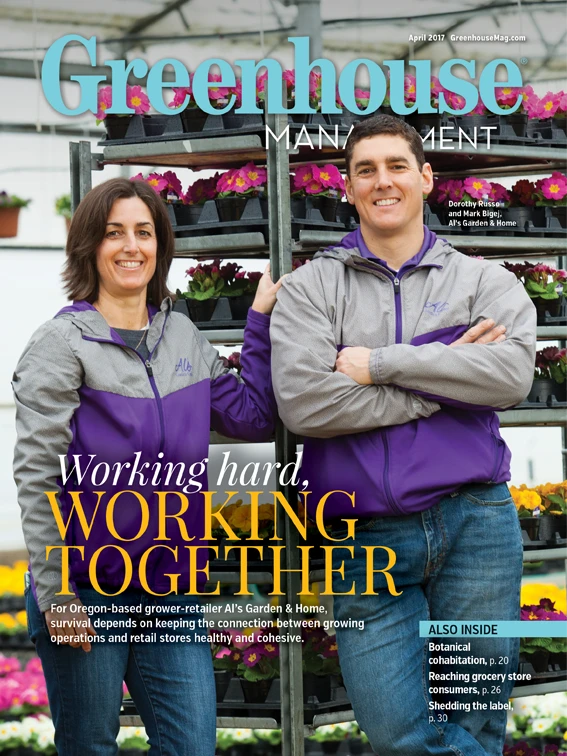
On Feb. 3, professors and graduate students from Michigan State University’s Department of Horticulture teamed up with AmericanHort to present lighting research at the university’s first-ever Lighting Solutions Open House.
The event was one of AmericanHort’s first University Pro series events, says Gina Zirkle, AmericanHort learning resource specialist. “Up-to-date information on lighting research and application techniques is a necessity for our members, so it seemed like a perfect fit to work with some of the leading experts in the industry to partner on this open house,” she says.
Two of those experts were Michigan State professor Dr. Erik Runkle and assistant professor Dr. Roberto Lopez, who reflected back on the event with Greenhouse Management.
Greenhouse Management: Why did you partner with AmericanHort to hold the Michigan State University Lighting Solutions Open House?
Roberto Lopez: We were aware that AmericanHort was launching a university road show focusing on various production topics. We approached them about co-hosting an event showcasing the photoperiodic, supplemental, and sole-source lighting [research] that we are conducting at Michigan State University.
GM: Who attended the event?
Erik Runkle: We had around 70 people attend, most of them were growers, and they came from nine different states and Ontario. We also had four event sponsors: HortAmericas, P.L. Light, Osram, and Philips.
GM: Who presented research at the event?
RL: Erik Runkle and his Ph.D student William Meng delivered a talk on low-intensity photoperiodic lighting. They focused their talk on different technologies and LED lighting options to accelerate flowering of long-day plants and inhibit flowering of short-day plants.
I gave a talk on high-intensity supplemental lighting from LEDs to increase the daily light integral for young plants or to increase pigmentation of crops such as lettuce and purple fountain grass. I also discussed key considerations when installing and operating supplemental greenhouse lighting.
Ph.D student Yujin Park and I delivered a talk on sole-source lighting of young plants and microgreens. We discussed how plant growth and development can be substantially manipulated by the light spectrum when plants are grown completely indoors, such as in growth chambers, warehouses, and vertical farms.
Erik Runkle presented information [to] help growers determine whether LED lighting is right for their operation by considering seven important factors that impact return on investment.
GM: What other recent LED-related events has Michigan State University participated in that have impacted how growers think about lighting?
RL: In May 2016, Erik and I were co-conveners of the International Society for Horticultural Science (ISHS) 8th International Symposium on Light in Horticulture in East Lansing, Mich. (lightsym16.com). The conference attracted over 250 participants from 25 countries around the world. This symposium is generally held every four years and provides an opportunity for researchers and industry professionals to share their knowledge, findings, and ideas on the subject of light in horticultural systems.
GM: From 2010 to 2015, Michigan State was part of the USDA Specialty Crop Research Initiative project “Developing LED lighting technologies and practices for sustainable specialty-crop production.” How did that project change growers’ perspectives about LED lighting?
ER: When we started the project on LEDs, in collaboration with Purdue, Arizona, Rutgers, and Orbitec, research-based information on LEDs for plant applications was very limited. Together, we learned about the many advantages of LEDs (as well as some of their limitations), but also realized there was a lot more research needed given the different ways LEDs can be used in plant production, and how differently plants can respond to light intensity and light quality.
GM: Have you scheduled or are you thinking about scheduling any other Michigan State lighting events for growers?
ER: We will likely host a similar event next year or perhaps in 2019. In the meantime, both Roberto and I will be delivering lighting talks at Cultivate'17 in Columbus in July and at the Production Technology Conference in Dallas in October.
GM: Which lighting topics will you two be discussing at Cultivate’17?
ER: Together, we will discuss greenhouse lighting considerations, including important lighting and production aspects to help you select what lighting (whether LED or conventional) is appropriate for your operation. Erik will also co-present a talk on controlling flowering with photoperiodic lighting.

Explore the April 2017 Issue
Check out more from this issue and find your next story to read.
Latest from Greenhouse Management
- 2025 Proven Winners Horticulture Scholarship applications now open
- How to improve inventory and shipping management in the greenhouse
- Leading Women of Horticulture: Anna Ball, Ball Hort, and Terri McEnaney, Bailey Nurseries
- GM CEA HERB Part 2: A guide to increasing the sowing density of culinary herbs
- GM CEA HERB Part 1: Best practices for producing culinary herbs in controlled environments
- USDA fires experts on invasive pests, including Asian citrus psyllid, chilli thrips
- CEA Alliance celebrates bipartisan introduction of Supporting Innovation in Agriculture Act
- Dümmen Orange North America celebrating 25th anniversary in 2025









